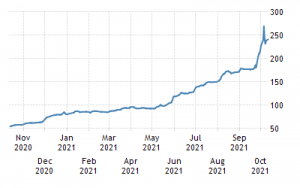
By: Vijay Jayaraj
Coal shortages have struck two of the world’s biggest energy consumers, threatening power outages for 2.7 billion people and raising prices for the fossil fuel to unprecedented levels. In China, factories are shut, homes remain in darkness, and chaos ensues on roads where traffic lights fail. Coal plants that supply neighboring India with 70% of its electricity are on the brink of running out of fuel, triggering an emergency call to the government for assistance.
China’s Guangdong Province has been experiencing regular blackouts, directly affecting a manufacturing hub that contributes around 10% of China's annual economic output. Some industries, despite a demand for their products, have lost as much as 50% of production in recent months.
“Power restrictions are likely to continue until March next year, and residents should prepare for water cuts to become normal,” said Guangdong media. Provincial energy regulators issued an advisory with the following guidance: “office workers to use stairs for the first three floors, shopping malls to keep advertising signs on fewer hours, and for homes to use natural light as much as possible and to keep air conditioners above 26 degrees Celsius.”
In all, 17 provinces — including the industrial centers of Jiangsu, Zhejiang and Shaanxi — rationed power this year. Last week, Northern Chinese provinces of Liaoning, Jilin and Heilongjiang suffered blackouts, with cuts to traffic lights wreaking havoc on roads during rush hour in at least one major city.
More provinces are planning power cuts. Some factories were notified that they won’t receive electricity until mid-October. “The power reductions surely had an impact on us, said a factory owner in Jiangsu Province. “Production has been halted, orders are suspended, and all our 500 workers are off on a month-long holiday,”
Many companies have been forced to shut for a few days a week, and the situation is expected to remain the same until 2022 as utilities are finding it difficult to procure coal for the winter.
Analysts say that major contributors to this shortage are China’s restrictions on coal use, the higher coal price, and the post-pandemic increase in electricity demand. “China’s coalprices surged to a record high last week,” says Stephen Stapczynski, Bloomberg’s energy and commodities reporter in Singapore. “That, combined with strong demand from industry-led rebound from the pandemic, continue to push coal prices higher.”
Meanwhile, India’s coal inventories hit a three-year low. “Coal’s price surge could also mean a shortage in India. Load on facilities fed with domestic coal has jumped, while demand is accelerating. Inventories are diminishing quickly, putting a rising number of plants at risk of shutdown,” says Stapczynski.
Largely underdeveloped until recently. India’s power sector was able to meet electricity demand only in 2017, thanks to a large increase in coal production and imports since the 2000s. During 1990s and 2010s power was heavily rationed, and blackouts were part of life. Now, more than a billion people stare at a similar situation after an SOS from coal plants and the aluminum industry revealed a severe coal shortage.
Unlike China, India has no restrictions on coal mining or coal imports. Although rainy weather currently hampers mining operations, coal production is expected to increase.
Nevertheless, rising coal prices will cause headaches that likely will worsen with the approaching winter, when China burns the highest amount of the fuel. So far in 2021, global coalprices have registered a 249% increase over last year.

The 2021 energy scare probably will have a long-lasting influence on domestic energy policies. A few years ago, China relaxed its coal ban after a severe winter left thousands helpless in its North. Similarly, India issued coal mining rights in its Northeast province to boost coal production after years of inactivity.
Europeans are being warned that they could be next as natural gas prices skyrocket and shortages are forecast for winter. Last month, the U.K. scrambled to increase power generation from natural gas- and coal-fired plants when wind turbines failed. This week, commuters in England were left immobile after a sudden shortage in petrol and diesel forced many gas stations to close and created hours-long queues at those that were open. The British prime minister even contemplated calling on the Army to maintain order at stations. If European leaders fail to act, more of the same can be expected this winter, particularly in countries heavily dependent on unreliable wind and solar energy.
Asia’s and Europe’s energy crisis is a stern warning to politicians who advocate replacing coal, oil and natural gas with more expensive and intermittent wind and solar — a switch that is a proven recipe for chaos and misery.
Vijay Jayaraj is a Contributing Writer to the CO2 Coalition, Arlington, Va., and holds a master’s degree in environmental sciences from the University of East Anglia, England. He resides in Bengaluru, India.





Leave a Reply
Thank you for your response.
Please verify that you are not a robot.